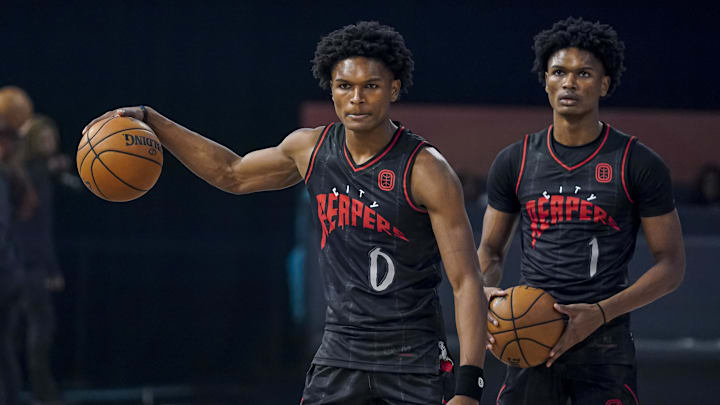The Thompson twins' strengths
As I alluded to earlier, the Thompson twins' most obvious strength is their athleticism--in nearly every sense of the word. They're lightning fast in the open court, have a Lonnie Walker-like float to their athleticism when they jump, and have an elite first, second, and third step when driving toward the basket from a standstill. Upon entry into the NBA, they'll be among the top athletes in the league.
Amen Thompson is widely considered a top-five prospect for the upcoming 2023 NBA Draft because of how freakish his athletic traits are
— The Box and One (@TheBoxAndOne_) January 5, 2023
To learn more about Amen and what his overall profile as a prospect looks like, check out our new scouting report here:https://t.co/NaU2CTdv4Z pic.twitter.com/Uj4c1FBbAz
Amen is often considered the slightly superior athlete, and while I don't necessarily disagree with that sentiment, the impact of their athleticism on the court will likely be nearly identical. They'll both be able to blow by most defenders in the league, easily finish above the rim on many occasions, and have the functional strength and lateral foot speed to keep up with most players on defense. Simply put, their athleticism alone gives them a massive upside because of how advanced it already is.
With that in mind, though, elite athleticism isn't enough to make players as highly touted as the Thompson twins are. Their ancillary skills that accompany their athleticism are what make them top-five-level prospects. Both Amen and Ausar are high-level playmakers, averaging 6 and 5 assists per game, respectively, and both can make difficult passes in transition and in the half-court. Amen appears to be the better live-dribble passer at the time of writing, but this could be more a result of role rather than sheer talent, which I'll speak more about later.
Being that both stand at roughly 6'7" with 6'11" wingspans, Amen and Ausar use their length to their advantage on both ends of the floor. They're both very good rebounders for their size, with Amen grabbing 6 per game and Ausar grabbing 7.7 per game. But they also use that length on defense, where Amen has earned 2.3 steals and just under 1 block per game, while Ausar averages 2.5 steals and 1.6 blocks (!!) per game. Generally speaking, both twins find ways to be productive outside of the 'points' column on stat sheets, which is important when factoring in some of their areas for improvement.
The Thompson twins' areas for improvement
The Thompson twins' most important area for improvement, and the one that rears its ugly head in nearly every scouting report you'll read on them, is their shooting. And contrary to popular opinion, I hold the belief that both players need quite a bit of work as scorers on all three levels. Both are hovering around the 70% mark from the free-throw line, with Amen sitting at 74% and Ausar sitting at 67%, which is approaching semi-okay efficiency, but they're also shooting 22% and 36% from beyond the arc, respectively. Ausar is quite clearly the better shooter at this point in their development, but both need to continue improving.
Perhaps even more concerningly, though, both brothers are also less efficient than one might assume around the rim. While their scoring efficiency in transition is certainly something to be excited about, that efficiency bloats their overall finishing numbers to the point that they appear far more impressive than they actually are in the half-court. Factoring out transition attempts, through Amen's first 10 games, he only made about 50% of his attempts at the rim, while Ausar made about 58% through his first 7 games. This Twitter thread from @drewgoodenssuit gives those numbers context quite well.
Ausar Thompson is FILTHY 🤮 pic.twitter.com/o4Zd3v1Txk
— Overtime Elite (@OvertimeElite) December 19, 2022
Outside of shooting and general scoring, if I were to pick one other area for improvement that both twins share, it's their ball handling. This is something that has widely been seen as one of their more positive attributes in scouting reports, and the high-level flashes they'll show (like in the tweet above) on occasion make me understand why. But in watching several full games, I've found that both brothers tend to stand a bit too high while they're maintaining a live dribble, making them prone to getting the ball ripped or poked away. On other occasions, they've lost their dribble without any defensive pressure at all.
This is something I'm far less concerned about compared to their shooting, but being that the Thompson twins' success as scorers at the next level is so predicated on them getting to the basket--particularly in half-court situations--watching how they continue to develop as ball handlers is crucial.
